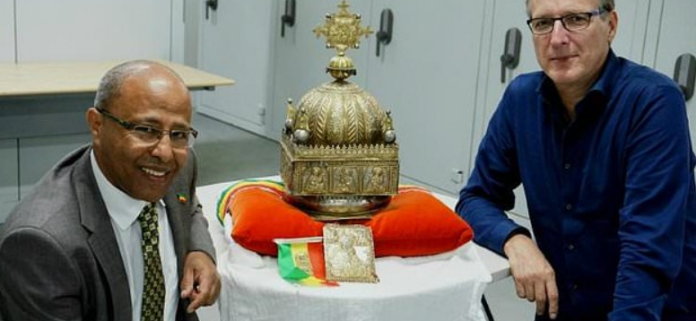Priceless Ethiopian Crown to be returned from Netherlands (October 2, 2019)
Priceless 18th-centuries Ethiopian Crown hidden for twenty one years by one-time Ethiopian refugee who found it in a suitcase is set to be returned from Netherlands to home.
The idea to return the ornate gilded copper headgear, featuring images of Christ and the Twelve Apostles, came after refugee-turned-Dutch-citizen Sirak Asfaw contacted Dutch ‘art detective’ Arthur Brand, it was learned.
According to AFP news agency, the crown, which is currently being held in a secure location, would soon be handed to Ethiopian authorities.
Sirak, who works as management consultant for the Dutch government today, fled the country in the late 1970s during the so-called “Red Terror” purges.
Once settled in the Netherlands, Sirak used to receive a stream of Ethiopians, including pilots and diplomats, along with people who had fled a continuous cycle of hardship in Africa’s most ancient country, the news agency reported.
While looking for a document, Sirak stumbled upon the crown in a suitcase left behind by one of his visitors in April 1998.
Despite the fact that he realized that it belongs to Ethiopia, he vacillated to return the crown home since the country was ruled by iron-fisted one-party government that would disappear it again.
Sirak, however, said that when Prime Minister Abiy Ahmed took office last year, he felt that things had changed sufficiently in Ethiopia to finally give the crown back.
The Dutch government too confirmed to AFP that Brand had told them about the crown’s existence saying “its authenticity will now have to be established in close cooperation with Ethiopian authorities,” before the next steps will be taken.
Jacopo Gnisci, a research associate at Oxford University who also examined the artifact and confirmed its authenticity, said there were less than two dozen of these crowns, called “zewd”, in existence.
“These crowns are of great cultural and symbolic significance in Ethiopia, as they are usually donated by high-ranking officials to churches in a practice that reaches as far back as the Late Antiquity,” he added.
This crown has an inscription dating to 1633-34, but Gnisci said it was more likely to have been made a century later and was commissioned by one of Ethiopia’s most powerful warlords, “ras” Welde Sellase.
The artifact is currently being stored at a high-security facility in the Netherlands.




Leave a Reply
Want to join the discussion?Feel free to contribute!